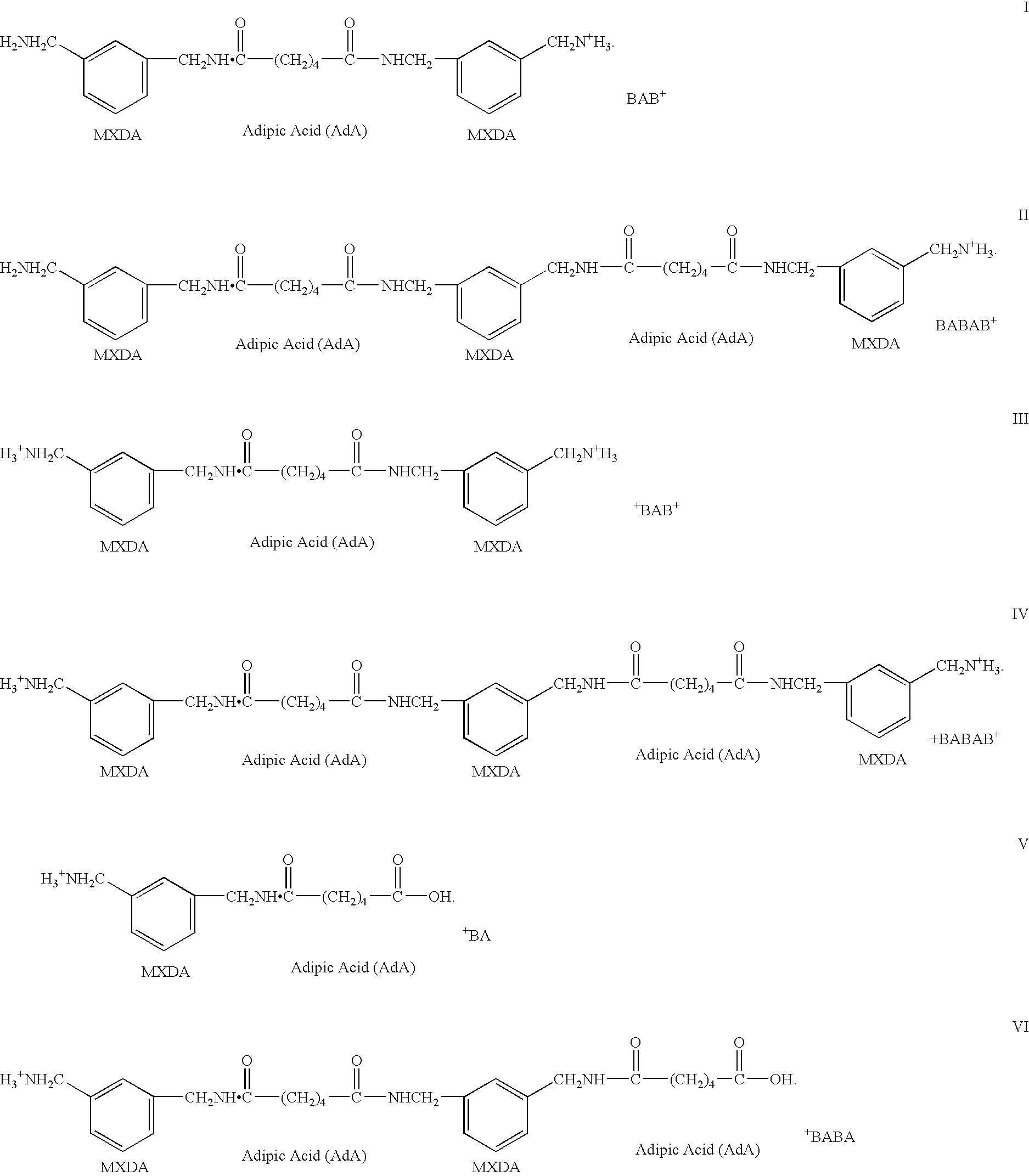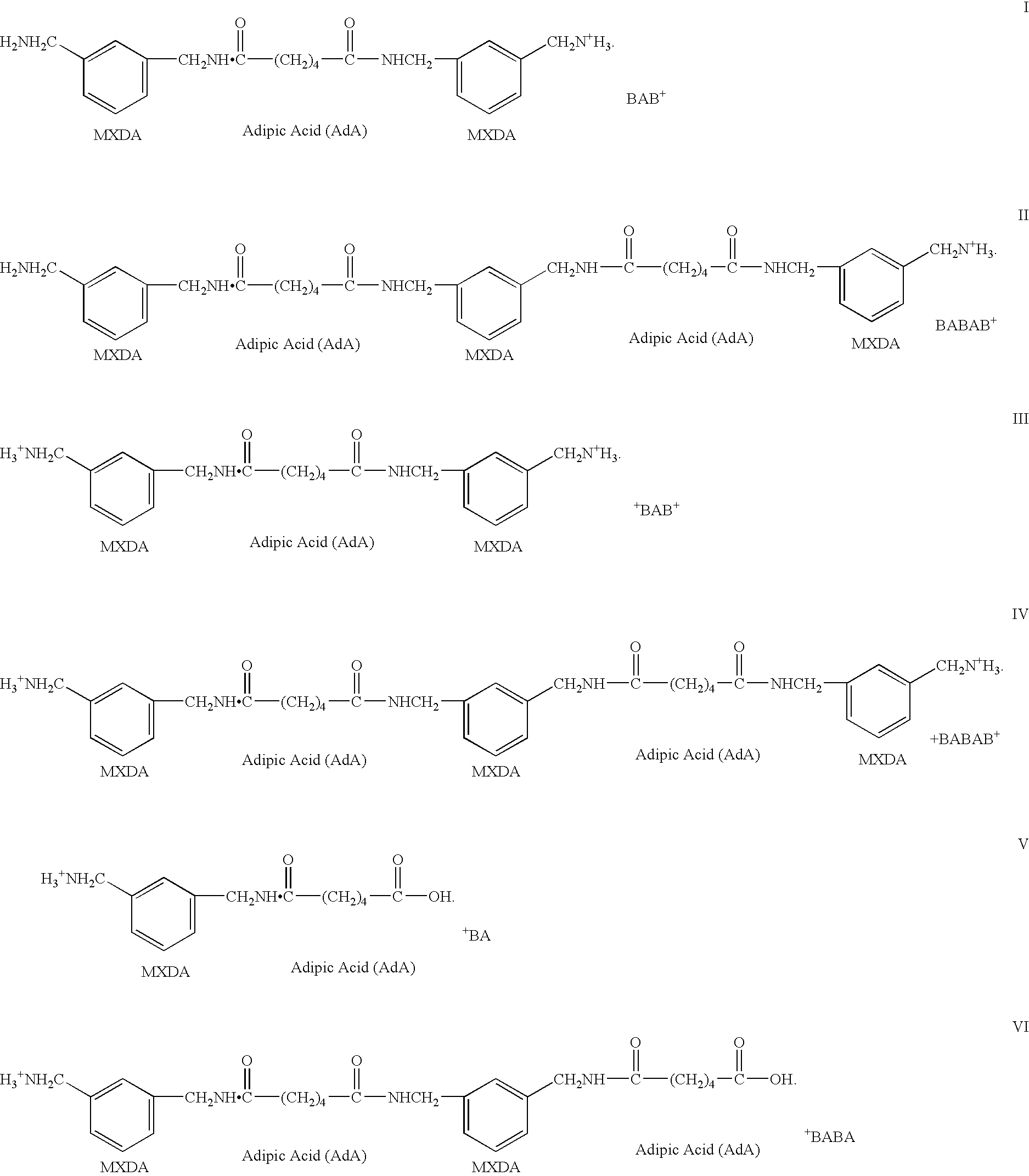Oligomer-modified layered inorganic compounds and their use in nanocomposites
a technology of inorganic compounds and oligomer modifications, which is applied in the field of intercalated layered silicate materials, can solve problems such as poor thermal stability, and achieve the effects of improving strength, gas/liquid barrier properties and/or temperature resistance, and reducing thermal degradation
- Summary
- Abstract
- Description
- Claims
- Application Information
AI Technical Summary
Benefits of technology
Problems solved by technology
Method used
Image
Examples
example-1
Preparation of m-xylylene-Containing Polyamide (BAB-Type) Oligomer
[0107] Into a jacketed reaction vessel equipped with a stirring device, a partial condenser, a cooler, a dropping funnel, and a nitrogen inlet, 3.40 mols (497 g) of adipic acid was introduced. After replacing the inner atmosphere with nitrogen, adipic acid was uniformly melted at 160° C. under a nitrogen stream. To the molten adipic acid, 6.80 mols (926 g) of m-xylylenediamine was continuously added dropwise under stirring. During the addition, the inner temperature was continuously raised to 220° C. The water distilled off with the addition of m-xylylenediamine and was removed from the reaction vessel through the partial condenser and the cooler. After completing the addition of m-xylylenediamine, the inner temperature was raised to 260° C. and the reaction was continued for 30 minutes. The resultant polyamide oligomer was cooled down and taken out in the form of a solid. The solid polyamide oligomer was ground. 1 k...
example 2
Preparation of Intercalate with Protonated Polyamide Oligomer in Water / Alcohol mixed Solvent
[0109] 20 g of montmorillonite (Kunipia-F produced by Kunimine industrial, capacity of ion-exchange: 1.2 meq / g) was added into 2 liters of distilled water and stirred at 80° C. for 2 hours. On the other hand, 10 g of the polyamide oligomer (BAB-type) obtained in example 1 was dissolved in 2 liters of distilled water / methanol (1 / 1 by volume) at 60° C. for 1 hour under stirring. Then 25 cc of 1N hydrochloric acid was added to ionize (protonate) an amine functionality of the intercalant oligomer. The solvent, including the amine-protonated polyamide oligomer, and the montmorillonite, dispersed in water, were mixed and stirred at 80° C. for 1 hour and the ion-exchange treatment (intercalation) of the montmorillonite clay was performed. After this ion-exchange treatment (intercalation), the settled montmorillonite was separated through filtering and was washed in 3 liters of distilled water. The ...
example 3
Preparation of Intercalate with Polyamide Oligomer in Water Media Only
[0110] 50 g of montmorillonite (PG-clay produced by Nanocor, Inc. capacity of ion-exchange; 1.0 meq / g) was added into 2 liters of distilled water and stirred at 80° C. for 2 hours. On the other hand, 19 g of the polyamide oligomer (BAB-type) obtained in example 1 was dissolved in 2 liters of distilled water at 80° C. for 1 hour under stirring. Then 25 cc of 2N hydrochloric acid was added to ionize (protonate) an amine functionality of the intercalant oligomer. The solvent, including the ionized (amine-protonated) polyamide oligomer, and the montmorillonite, dispersed in water, were mixed and stirred at 80° C. for 1 hour and the ion-exchange treatment for montmorillonite clay was performed. After this ion-exchange treatment (intercalation), the settled montmorillonite was separated through filtering and was washed in 3 liter distilled water. The obtained polyamide-oligomer-silicate (intercalate) was dried at 80° C...
PUM
| Property | Measurement | Unit |
|---|---|---|
| Fraction | aaaaa | aaaaa |
| Fraction | aaaaa | aaaaa |
| Fraction | aaaaa | aaaaa |
Abstract
Description
Claims
Application Information
 Login to View More
Login to View More - R&D
- Intellectual Property
- Life Sciences
- Materials
- Tech Scout
- Unparalleled Data Quality
- Higher Quality Content
- 60% Fewer Hallucinations
Browse by: Latest US Patents, China's latest patents, Technical Efficacy Thesaurus, Application Domain, Technology Topic, Popular Technical Reports.
© 2025 PatSnap. All rights reserved.Legal|Privacy policy|Modern Slavery Act Transparency Statement|Sitemap|About US| Contact US: help@patsnap.com



